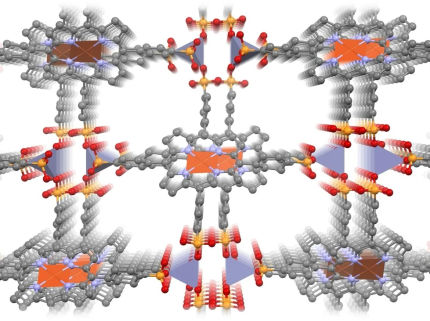Porous Crystals Detect Nitric Oxide
Ultrasensitive detection of NO using a conductive 2D metal–organic framework
Detection of nitric oxide (NO) is important for monitoring air quality because the NO released in the combustion of fossil fuels contributes to acid rain and smog. In medicine, NO is an important messenger molecule and serves as a biomarker for asthma. In the journal Angewandte Chemie, a research team now reports a material that can detect NO reversibly, with low power, and with high sensitivity and selectivity: a copper-containing, electrically conducting, two-dimensional metal–organic framework.

© Wiley-VCH
Metal–organic frameworks (MOFs) are latticelike structures consisting of metal “nodes” connected by organic bridges (ligands). An emerging class of MOFs are electrically conducting structures consisting of layers. These 2D-cMOFs have demonstrated great potential as chemiresistive sensors that react to the presence of specific molecules with a change to their electrical resistance, which may allow for particularly sensitive and low-power detection of toxic gases. Problems with such systems have included cross-reactivity with a variety of gases and limited reusability due to irreversible binding of the analytes.
Katherine A. Mirica, Christopher H. Hendon, and their team at Dartmouth College (Hanover, NH, USA), the University of Oregon (Eugene, OR/USA), and Ulsan National Institute of Science and Technology (South Korea), have now developed a reusable 2D-cMOF for the highly selective detection of NO. They chose to use a 2D-cMOF based on copper and hexaiminobenzene, Cu3(HIB)2. Thanks to their different synthetic strategy (the linker was added as an undissolved powder to a solution of Cu2+ ions and potassium acetate), the team produced a material with significantly higher crystallinity (rod-shaped crystallites about 500 nm in length) than has previously been attained.
The crystallites consist of stacked layers of a weblike structure of six-membered rings linked together by copper ions bound to their nitrogen atoms. Spectrometric analyses and computations revealed that the binding sites for NO were Cu-bis(iminobenzosemiquinone) units of the copper-2D-cMOFs. An analogous compound made with nickel instead of copper demonstrated no significant absorption of NO. Evidently, copper ions with a single positive charge, which are present in small amounts in the structure besides those with a twofold positive charge, play an important role in binding NO. Computational studies suggest that the adsorbed NO significantly distorts the structure, destabilizing the bound state, which is the primary cause for the desirable reversibility of the NO adsorption.
This new sensor material detects NO at room temperature and low voltage (0.1 V) with high sensitivity (detection limit about 1.8 ppb) and could be reused for at least seven cycles without regeneration. Quantitative measurements of NO were also successful in the presence of moisture, and showed high enhancement of sensor signal towards NO in comparison to other gases, such as nitrogen dioxide, hydrogen sulfide, sulfur dioxide, ammonia, and carbon monoxide and dioxide.
Original publication
Hyuk‐Jun Noh, Doran L. Pennington, Jeong‐Min Seo, Evan Cline, Georganna Benedetto, Jong‐Beom Baek, Christopher H. Hendon, Katherine A. Mirica; "Reversible and Ultrasensitive Detection of Nitric Oxide Using a Conductive Two‐Dimensional Metal–Organic Framework"; Angewandte Chemie International Edition, 2024-12-2
Most read news
Original publication
Hyuk‐Jun Noh, Doran L. Pennington, Jeong‐Min Seo, Evan Cline, Georganna Benedetto, Jong‐Beom Baek, Christopher H. Hendon, Katherine A. Mirica; "Reversible and Ultrasensitive Detection of Nitric Oxide Using a Conductive Two‐Dimensional Metal–Organic Framework"; Angewandte Chemie International Edition, 2024-12-2
Topics
Organizations
Other news from the department science

Get the chemical industry in your inbox
By submitting this form you agree that LUMITOS AG will send you the newsletter(s) selected above by email. Your data will not be passed on to third parties. Your data will be stored and processed in accordance with our data protection regulations. LUMITOS may contact you by email for the purpose of advertising or market and opinion surveys. You can revoke your consent at any time without giving reasons to LUMITOS AG, Ernst-Augustin-Str. 2, 12489 Berlin, Germany or by e-mail at revoke@lumitos.com with effect for the future. In addition, each email contains a link to unsubscribe from the corresponding newsletter.
Most read news
More news from our other portals
Last viewed contents





























































